A Clash of Babels


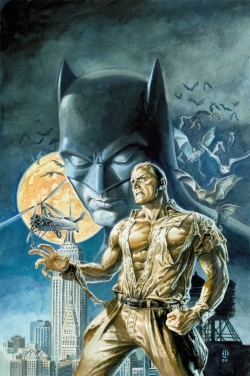 The comic book superhero was born in the late 1930s, during the time when the dominant form of popular culture reading was the pulp magazine. During the next decade, the pulps would start their slow demise: wartime paper shortages that forced the publishers to cut back on the more risky material to focus on the steady sellers, the paperback influx competed on the genre scene and were popular with soldiers overseas, and the rise of the comic book took away much of the younger readers. That the comic book should play such a large part in the end of the pulp magazine industry is an ironic reversal, since the hero pulps fueled the creation of those first four-color superheroes. No Batman without the Shadow. No Superman without Doc Savage.
The comic book superhero was born in the late 1930s, during the time when the dominant form of popular culture reading was the pulp magazine. During the next decade, the pulps would start their slow demise: wartime paper shortages that forced the publishers to cut back on the more risky material to focus on the steady sellers, the paperback influx competed on the genre scene and were popular with soldiers overseas, and the rise of the comic book took away much of the younger readers. That the comic book should play such a large part in the end of the pulp magazine industry is an ironic reversal, since the hero pulps fueled the creation of those first four-color superheroes. No Batman without the Shadow. No Superman without Doc Savage.
The comic book industry is now doing some payback to the long-vanished cheap paper fiction magazines. DC Entertainment Inc. has an upcoming project where they are going to let their characters revert back to the 1930s and turn into true pulp heroes once more. It’s an alternate universe version of the DC Universe with no super-powered characters, set firmly in the 1930s. And it will not only feature their own creations like Batman, but also genuine pulp stars Doc Savage and the Avenger, to whom DC owns the comic book rights. The first publication in the new setting is next month’s Batman/Doc Savage Special, written by Brian Azzarello and illustrated by Phil Noto.
That’s all you need to get my blood a’ rushing. I rarely buy DC or Marvel monthly comics, since I think their indulgence in crossover mega-events has reached a level of mania/boredom, but this… oh, I am all over this in so many ways. Just having Doc Savage back in comics is enough, but Batman is also going to get pulled back to the decade of his nativity. I love comic book superheroes (Batman in particular), but since my mid-twenties I’ve turned more toward the pulp characters (The Shadow in particular), and seeing them get a whole corner of the universe of one of the two big comic book publishers is like a five-Red Bull high. And behold the Bama-influenced Doc Savage on the cover!
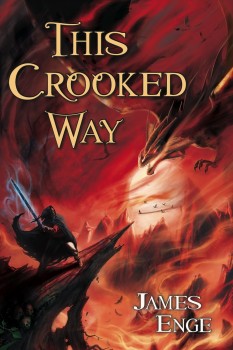 James Enge’s Morlock stories have been some of the most popular fiction we’ve published in Black Gate. His first Morlock novel, Blood of Ambrose, published by Pyr in April, was very warmly received, and described as “A future classic… this novel succeeds beautifully” (The Great Geek Manual) and “Like Conan as written by Raymond Chandler” (Paul Cornell).
James Enge’s Morlock stories have been some of the most popular fiction we’ve published in Black Gate. His first Morlock novel, Blood of Ambrose, published by Pyr in April, was very warmly received, and described as “A future classic… this novel succeeds beautifully” (The Great Geek Manual) and “Like Conan as written by Raymond Chandler” (Paul Cornell).
The second volume, This Crooked Way, went on sale October 6th. More than just a collection of previously published Morlock fiction, This Crooked Way has 15 chapters, only 5 of which have previously appeared. We’ve received a small number of advance copies, and we want to give them to you.
We’ve asked James Enge to compile a list of questions, the answers to which lie in the five Morlock stories that have appeared in Black Gate. The first five readers to fill out and submit the quiz below with the correct answers will receive a copy of This Crooked Way, compliments of Black Gate, James Enge, and Pyr.
The usual legal disclaimers apply: Offer void where prohibited. No purchase necessary. Must be 18 to enter. Judges decisions are final. Postage costs outside the US are the responsibility of the winner. Additional disclaimers apply as we think of them. Eat your vegetables.
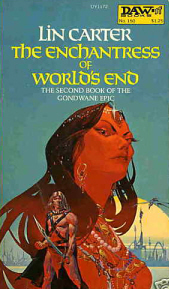 Linwood Vrooman Carter (1930-1988) was one of the heroes of my youth. In the decades since his death his reputation has wallowed in the aftermath of the Last Great Sword & Sorcery Boom. He helped start it, with the Conan books he and L. Sprague de Camp brought back into print, edited, and in many cases wrote, as with the Ballantine Adult Fantasy Series of works he edited and thus brought back into print. (Not adult fantasy as in sex, but adult fantasy as in great classic works that weren’t kid stuff). Books by Lovecraft and Clark Ashton Smith and James Branch Cabell; title I never would’ve read in a million years otherwise, but books which shaped the tastes of many another fantasy enthusiast, myself among them.
Linwood Vrooman Carter (1930-1988) was one of the heroes of my youth. In the decades since his death his reputation has wallowed in the aftermath of the Last Great Sword & Sorcery Boom. He helped start it, with the Conan books he and L. Sprague de Camp brought back into print, edited, and in many cases wrote, as with the Ballantine Adult Fantasy Series of works he edited and thus brought back into print. (Not adult fantasy as in sex, but adult fantasy as in great classic works that weren’t kid stuff). Books by Lovecraft and Clark Ashton Smith and James Branch Cabell; title I never would’ve read in a million years otherwise, but books which shaped the tastes of many another fantasy enthusiast, myself among them.
Despite the vast number of books written in the Sword & Sorcery genre in the past 80 years, when I found myself again turning an eye toward them, one of the first people I sought out was Carter. I distinctly remember the day, age 13, when I bought his Enchantress of World’s End off the spin rack at the Wal-Mart in Harrison, Ark.
The bare-bosomed, bright red beauty on the cover caught my eye, as did the unpronounceable names (Northern YamaYamaLand, Dzimdazoul’s Deep – not to mention the Ethical Triumvirs of Chx!), and of course the cast: Ganelon Silvermane, muscle-clad hero with the mind of a child, his master the Illusionist of Nerelon, face always hidden behind veil of purple mist, and the delightful, freckled, long-legged and sexy Xarda, Knightrix of Jemmerdy.
Over at Torque Control, the blog of the editorial staff of the British Science Fiction Association journal Vector, there’s a weekly short story roundtable discussion. This week’s subject is Ken McLeod’s “A Tulip for Lucretius”. As I write this, I haven’t read the whole story, but it certainly has an attention-getting opening paragraph.
There’s also a discussion about the relative utility of book reviews, inspired by a Huffington Post proclamation that, if I understand correctly, it will blog about books, but not “review” them. Given that blogging in general is conversational, highly opinionated (often without substantive argumentation, let alone sophisticated discussion), and neither edited nor fact-checked, I fail to see why this is an improvement. Though, yeah, I know you could say the same thing about some reviews.
 I’ve been in reviewer overload lately, reading, taking notes, and penning reviews for the next issue of Black Gate. But, more than that, I’ve also been coordinating our crop of reviewers this time out, and thinking in terms of what exactly it is that ought to be in the review section of the magazine, not just in the reviews I put up on my own website. Having done over 50 reviews in the last year and a half or so, I think I’ve learned a few things, and I’d like to share my thoughts on what a good review should consist of. And at the end of this essay I’ll also offer some practical advice to anyone that wants to become a web reviewer themselves and share the reasons behind just why someone would want to take the time to review a book in the first place.
I’ve been in reviewer overload lately, reading, taking notes, and penning reviews for the next issue of Black Gate. But, more than that, I’ve also been coordinating our crop of reviewers this time out, and thinking in terms of what exactly it is that ought to be in the review section of the magazine, not just in the reviews I put up on my own website. Having done over 50 reviews in the last year and a half or so, I think I’ve learned a few things, and I’d like to share my thoughts on what a good review should consist of. And at the end of this essay I’ll also offer some practical advice to anyone that wants to become a web reviewer themselves and share the reasons behind just why someone would want to take the time to review a book in the first place.
The first distinction we need to make is between a book review and a book report. Reviews are critiques that take a lot of factors into consideration and demand a certain level of knowledge and discernment from the reviewer. Book reports are those bland plot summaries you used to have to write in school to prove to the teacher you actually did your assigned reading. I’ve seen so-called reviewers whose work falls squarely into the later category but, aside from generating web content for google, such work holds little real value.
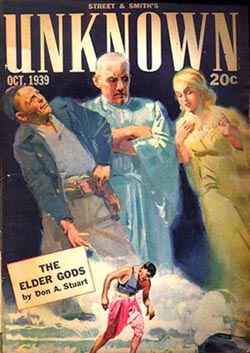 I’m guest-blogging this week at Babel Clash, along with fellow Pyr author Matt Sturges, and for the past couple days we’ve been kicking around the topic of our influences and anti-influences. It’s not always the biggest books or the best that are influences, though. For instance…
I’m guest-blogging this week at Babel Clash, along with fellow Pyr author Matt Sturges, and for the past couple days we’ve been kicking around the topic of our influences and anti-influences. It’s not always the biggest books or the best that are influences, though. For instance…
Don A. Stuart‘s “The Elder Gods” is a fantasy novella from the late 1930s that reads a lot like the science fiction being written around the same time. That’s no accident: the author behind the pseudonym is John W. Campbell, once a leading light in the “super science” stories of the 1930s, later a pioneer of a more sophisticated form of speculative fiction, and (by the time the work under review appeared) he was well into his third and longest career as the influential editor of Astounding Science Fiction–and the new fantasy magazine Unknown, in which “The Elder Gods” first appeared. (I reread it in a rather battered copy of the 1970s Ace reprint of The Moon is Hell; but there’s a NESFA edition of Campbell’s Stuart stories, including “The Elder Gods”. That’s what I’d recommend seeking out, if you’re interested, as there are some typographical glitches in the Ace edition; plus, it may be harder to find; plus, I’ve always thought “The Moon Is Hell” was a stupid title.)
In Unknown, Campbell didn’t want to create yet another knockoff of Weird Tales; the tagline for the paper-covered anthology From Unknown Worlds was “Fantasy Stories for Grown Ups”–by which he seems to have meant the serious grownups who were reading Astounding. Lots of his Astounding writers crossed over to write for Unknown, and “The Elder Gods” was apparently his how-to-do-it example, applying the Astounding method of speculative fiction to fantasy.
[ Spectacular Stories of Scientific Theology beyond the jump.]
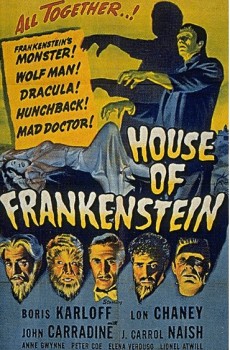 House of Frankenstein (1944)
House of Frankenstein (1944)Directed by Erle C. Kenton. Starring Boris Karloff, Lon Chaney Jr., John Carradine, J. Carrol Naish, Glenn Strange, Anne Gwynne, Elena Verdugo, George Zucco, Lionel Atwill.
I was working in the lab, late one night…
Ah, October. My favorite month. No other time is so ideal for exploring dark fantasy, the Gothic, the classic ghost story … and of course, Universal horror films. The monsters of Universal’s 1930s and ‘40s films have given the Halloween season its mascots, creatures as closely identified with the holiday as Santa Claus is with Christmas. So there’s no better Halloween party flick than the wall-to-wall monster epic that was the original “The Monster Mash”…
In seventy-one minutes, House of Frankenstein brings you:
All this, plus the hat trick of Boris Karloff, Lon Chaney Jr., and John Carradine in the same film; roles for classic supporting actors Lionel Atwill and George Zucco; and sexy Anne Gwynne. Now how much would you pay?
I paid $8.99 for my DVD, and I got Frankenstein Meets the Wolf Man on the same disc!
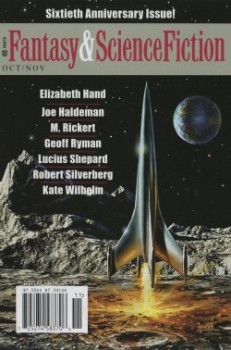 Fans of Tom Waits are often divided into two camps: those who favor the early boozy Kerouac, be-bop inspired crooner of life’s derelicts and losers up until he transmogrified beginning with the “Heartattack and Vine” album and “crossed over” into Kurt Weill cacaphonous orator of the absurd; fans of the later period sometimes disdain the earlier, and vice versa, despite the obvious connections. Me, I’m in the third camp as a huge admirer of both milieus. (I suppose there’s a further quarter of people who can’t stand Waits at all, but, much like the folks who still tiresomely maintain Dylan hasn’t done anything since his protest days, aren’t worth serious attention.)
Fans of Tom Waits are often divided into two camps: those who favor the early boozy Kerouac, be-bop inspired crooner of life’s derelicts and losers up until he transmogrified beginning with the “Heartattack and Vine” album and “crossed over” into Kurt Weill cacaphonous orator of the absurd; fans of the later period sometimes disdain the earlier, and vice versa, despite the obvious connections. Me, I’m in the third camp as a huge admirer of both milieus. (I suppose there’s a further quarter of people who can’t stand Waits at all, but, much like the folks who still tiresomely maintain Dylan hasn’t done anything since his protest days, aren’t worth serious attention.)
A similar kind of division exists in genre. Those who regale the Golden Age of pulp when men were men and women’s curves were accentuated by tight-fitting space suits and can’t stand all this new weird, new wave, fabulist whatever it’s being called, stuff that frequently has a radical socio-political feminist agenda (see, for example, Dave Truesdale) as opposed to those who welcome a reinvigoration of stale conventions (me, for example).
Then there are those whose eclectic tastes recognize and appreciate the connections of the old and new. This brings us to the 60th Anniversary Issue (October/November) of Fantasy & Science Fiction, which blends both the newer literary stylings as well as its pulp antecedents in celebrating its longevity (no mean trick, these days) as a classic genre magazine.
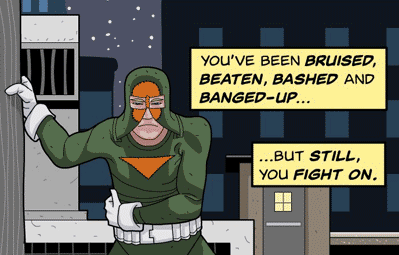 Before he became a regular artist for Black Gate, Bernie Mireault was already something of a Renaissance man in the comics industry. He’s been a writer, artist, letterer, and highly acclaimed colorist, and worked with Matt Wagner (Grendel), Joe Matt, Mike Allred, and many others. His comics include Dr. Robot, Bug-eyed Monster, The Blair Witch Chronicles, and his masterpiece, The Jam.
Before he became a regular artist for Black Gate, Bernie Mireault was already something of a Renaissance man in the comics industry. He’s been a writer, artist, letterer, and highly acclaimed colorist, and worked with Matt Wagner (Grendel), Joe Matt, Mike Allred, and many others. His comics include Dr. Robot, Bug-eyed Monster, The Blair Witch Chronicles, and his masterpiece, The Jam.
Our first meeting (that we know of) was in 1985, when Bernie crashed at my home in Ottawa, Canada. I was living with my parents while I studied at the University of Ottawa, and Bernie and his fellow creators with Montreal-based Matrix Comics were attending a local comics con. Bernie had just published the first issue of Mackenzie Queen, a marvelous piece of satirical horror featuring an exiled demon with a taste for dripping meat, who learns to be satisfied with Corn Flakes (“at least they drip.”) It was one of the first comics to make me laugh out loud. I’d been corresponding with Mark Shainblum at Matrix for months, and when I learned he was coming to town, I graciously offered my parent’s home as crash space (pretty sure I neglected to check with my parents first, which is part of what made it so gracious). Mark brought Gabriel Morrissette and Bernie Mireault, and the rest is history.
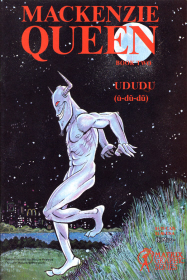 I say “first meeting that we know of” because Bernie and I were born in the exact same (and very small) place — a Canadian Air Force base in Marville, France — only a few years apart in the early 60s. Did we pass briefly as toddlers in the officer’s mess, and maybe compare our love for cartoons and comics while our fathers saluted each other over trays of french bread and beans? Probably not. But hey, man. It’s possible.
I say “first meeting that we know of” because Bernie and I were born in the exact same (and very small) place — a Canadian Air Force base in Marville, France — only a few years apart in the early 60s. Did we pass briefly as toddlers in the officer’s mess, and maybe compare our love for cartoons and comics while our fathers saluted each other over trays of french bread and beans? Probably not. But hey, man. It’s possible.
We lost touch for a few years when I moved to the US to finish grad school (and meet a girl from California and get married, but that’s another story). But I followed Bernie’s career closely. It wasn’t hard — he was all over the place, from Wonder Woman to Mr. Monster to Tales of the Batman. He even showed up — along with Matt Wagner — in Joe Matt’s autobiographical classic, Peep Show, as a minor character named only “Bernie.” But I recognized him immediately. Who wouldn’t?
But enough of trying to describe how cool Bernie is. To understand, you need to experience his work. And now you can!